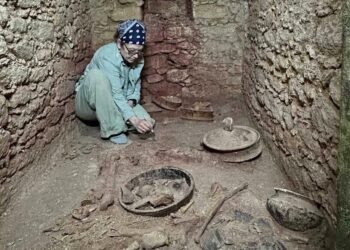A Buddhist temple dating back to the Northern Wei Dynasty (386-534) has been unearthed in Datong City of north China’s Shanxi Province.
This temple, believed to have served as either an official sanctuary or a royal edifice, stands approximately 300 meters from the ruins of a Northern Wei Dynasty palace, indicating its historical importance.

The temple’s central feature is a pagoda, which according to the provincial institute of archaeology, may have been a focal point for worship and spiritual activities during the era. Recent excavations within the pagoda’s foundations have unveiled a wealth of artifacts.
Among the discoveries is a square pit containing a treasure trove of items, including pearls, coral jewelry, and brass rings. These artifacts offer valuable glimpses into the material culture and religious symbolism of the Northern Wei Dynasty. Additionally, researchers have uncovered more than 200 well-preserved Buddhist statues inside the pagoda, showcasing the era’s exquisite craftsmanship and religious devotion.
Some statues are adorned with vibrant paint, while others feature delicate gold foil embellishments, showcasing the reverence and skill of the period’s artisans.
Further exploration has revealed evidence suggesting that the pagoda once boasted intricate murals adorning its walls. Despite the passage of centuries, remnants of peeling paint hint at the grandeur that once graced the temple’s sacred halls.
Li Shuyun, deputy head of the provincial institute of archaeology, said: “It is the most well-preserved pagoda foundation remains that Datong has ever discovered, providing important physical research materials for the study on architectural forms of Buddhist pagodas at that time.”
























